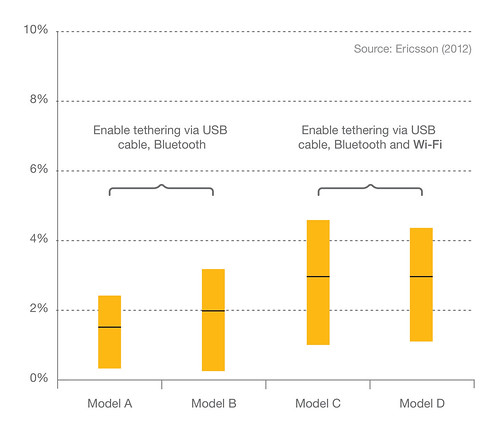 Ericsson published its Mobility Report for Q3, 2012 with lots on interesting data on mobile traffic, devices, coverage speed and penetration. See "Ericsson Mobility Report Shows Rapid Smartphone Uptake and Doubling of Mobile Data Traffic" - here and here and the report itself (here).
Ericsson published its Mobility Report for Q3, 2012 with lots on interesting data on mobile traffic, devices, coverage speed and penetration. See "Ericsson Mobility Report Shows Rapid Smartphone Uptake and Doubling of Mobile Data Traffic" - here and here and the report itself (here).
Among the more surprising finding is the relatively low percentage of on-line video - 25-40%, even for tablets. While 20% were classified as "others" and some other classes (like social) may also carry video this is still lower share compared to other reports (which usually shows 40% as the lowest value).
Tethering also shows small percentage (2-3%) - so either the surcharges prevent users for using it, it is too complicated to use or just not useful ...
Some highlight related traffic management:
- Traffic Mix - the chart below ".. shows how the most widely used online applications contribute to overall mobile data traffic volumes, and how these contributions vary by the type of connected device. This is based on average values from the measured networks. Actual values in individual networks can differ a lot. Regardless of device type, online video is the biggest contributor to traffic volumes (25-40 percent), followed by web browsing (15-20 percent). Traffic drawn from mobile PCs is notable for having significantly higher file sharing activity than other devices. Online audio, email, software downloads and social networking are also important contributors to data traffic on tablets and smartphone devices. The file sharing part under smartphones comes from tethering traffic.
- Tethering - The next chart "shows the penetration of tethering from mobile phones with different operating systems. Tethering can easily be set up on the majority of Android and iPhone devices currently available on the market. This is one reason why these devices are the ones most commonly used for tethering. There is a large variation between networks created by different operator policies towards tethering. On the average network, around 3.5 percent of Android smartphones are used to tether other devices and enable internet access. The tethering penetration is around six percent in the network with the highest amount of Android tethering users. One trend is that operators increasingly charge consumers for tethering devices. However, some regulator and consumer interest groups have opposed introducing tethering fees to data plans.
Mobile data tethering traffic was identified correlating the IMEI TAC (terminal identifier) of the terminal accessing the HSPA network and the user agent HTTP header field containing information about the end user terminal and application. Identifying tethering with the same terminal model is thus not possible. Measurements were performed during one week. The percentage of tethering users would be higher if measured over a month. Only subscriptions with data traffic are considered, voice-only subscriptions are excluded".
[the chart shows the largest value measured in one of the networks, Average value of the measured networks’ values (black line) and the smallest value measured in one of the networks]






The file sharing part under smartphones targeted traffic software comes from tethering traffic.
ReplyDelete